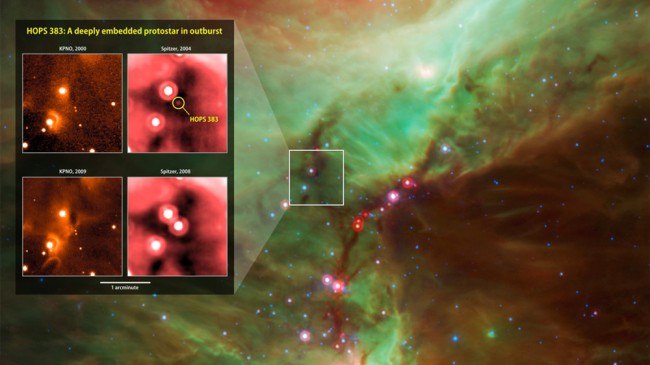Infrared images from instruments at Kitt Peak National Observatory (left) and NASA's Spitzer Space Telescope document the outburst of HOPS 383, a young protostar in the Orion star-formation complex. Background: A wide view of the region taken from a Spitzer four-color infrared mosaic. E. Safron et al.; Background: NASA/JPL/T. Megeath (U-Toledo)
The observed outburst reveals a sudden accumulation of gas and dust.
By NASA’s Goddard Space Flight Center, Greenbelt, Maryland, Jet Propulsion Laboratory, Pasadena, California | Published: Tuesday, March 24, 2015
Using data from orbiting observatories, including NASA’s Spitzer Space Telescope and ground-based facilities, an international team of astronomers has discovered an outburst from a star thought to be in the earliest phase of its development. The eruption, scientists say, reveals a sudden accumulation of gas and dust by an exceptionally young protostar known as HOPS 383.
Stars form within collapsing fragments of cold gas clouds. As the cloud contracts under its own gravity, its central region becomes denser and hotter. By the end of this process, the collapsing fragment has transformed into a hot central protostar surrounded by a dusty disk roughly equal in mass, embedded in a dense envelope of gas and dust. Astronomers call this a “Class 0” protostar.
“HOPS 383 is the first outburst we’ve ever seen from a Class 0 object, and it appears to be the youngest protostellar eruption ever recorded,” said William Fischer from NASA’s Goddard Space Flight Center in Greenbelt, Maryland.
The Class 0 phase is short-lived, lasting roughly 150,000 years, and is considered the earliest developmental stage for stars like the Sun.
A protostar has not yet developed the energy-generating capabilities of a Sun-like star, which fuses hydrogen into helium in its core. Instead, a protostar shines from the heat energy released by its contraction and by the accumulation of material from the disk of gas and dust surrounding it. The disk may one day develop asteroids, comets, and planets.
Because these infant suns are thickly swaddled in gas and dust, their visible light cannot escape. But the light warms dust around the protostar, which reradiates the energy in the form of heat detectable by infrared-sensitive instruments on ground-based telescopes and orbiting satellites.
HOPS 383 is located near NGC 1977, a nebula in the constellation Orion and a part of its sprawling star-formation complex. Located about 1,400 light-years away, the region constitutes the most active nearby “star factory” and hosts a treasure-trove of young stellar objects still embedded in their natal clouds.

